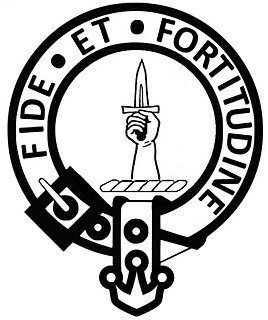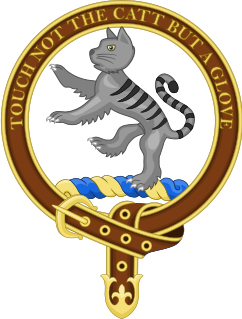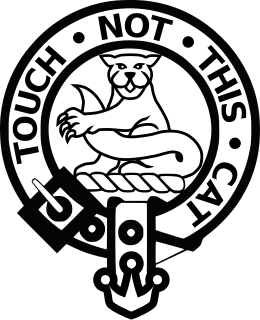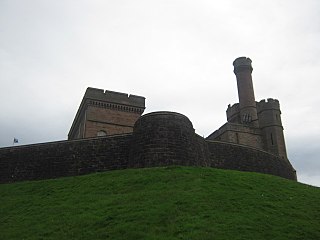Moy Hall near the village of Moy, south of Inverness, is the home of the chiefs of the Clan Mackintosh, a Highland Scottish clan.
Moy Hall near the village of Moy, south of Inverness, is the home of the chiefs of the Clan Mackintosh, a Highland Scottish clan.
The original Moy Hall was built in about 1700 to replace Moy Castle which was on Moy Island on Loch Moy. [1]
Jacobite supporter Lady Anne Farquharson-MacKintosh entertained Charles Edward Stuart here in 1746. Lady MacKintosh learned that government forces were advancing to capture Stuart and she arranged for four of her men to hide by the roadside when the government troops approached. Setting off their pistols to fire one at a time, they shouted for Clan MacDonald and Clan Cameron to advance, thus tricking the government forces into thinking they had stumbled into the whole of the Jacobite Army. Government forces speedily retreated and the event is remembered as the "Rout of Moy". [1]
The Moy Hall that was built in about 1700 was accidentally burned down in the time of Aneas Mackintosh, 23rd chief (died 1820). He had another Moy Hall built in about 1800 which was remodeled in the 1870s when the tower and two large wings were added. It was discovered to have dry rot, and despite remedial treatment was demolished in the 1950s. It was replaced with a much plainer house that was built 1955-57. [1] The new Moy Hall, built nearby, is a somewhat smaller but comfortable home which retains various features from the old place, such as the wooden panelling. [1]

Clan Donald, also known as Clan MacDonald, is a Highland Scottish clan and one of the largest Scottish clans. The Lord Lyon King of Arms, who is the Scottish official with responsibility for regulating heraldry in that country, issuing new grants of coats of arms, and serving as the judge of the Court of the Lord Lyon, recognizes under Scottish law the High Chief of Clan Donald. Historically the chiefs of the Clan Donald held the title of Lord of the Isles until 1493 and two of those chiefs also held the title of Earl of Ross until 1476.

Clan Shaw is a Highland Scottish clan and is a member of the Chattan Confederation.

Clan Farquharson of Invercauld is a Highland Scottish clan and is a member of Clan Chattan.

Clan Chattan is a unique confederation of Highland clans. The clan is distinctive in highland clan history in that it was acknowledged to be a community or confederation, of twelve separate Scottish clans, who each had their own clan chief recognized under Scottish law, but who were united under and bound to a superior chief of the confederation for mutual solidarity, sustenance and protection in the Middle Ages and early modern period in the Scottish Highlands.

Clan Mackintosh is a Scottish clan from Inverness in the Scottish Highlands. The chiefs of the clan are the Mackintoshes of Mackintosh. Another branch of the clan, the Mackintoshes of Torcastle, are the chiefs of Clan Chattan, a historic confederation of clans.

The Battle of Glen Shiel took place on 10 June 1719 in the West Scottish Highlands, during the 1719 Jacobite Rising. A Jacobite army composed of Highland levies and Spanish marines, was defeated by British troops, reinforced by a Highland Independent Company.

Anne Mackintosh (1723–1784) was a Scottish Jacobite of the Clan Farquharson, a Scottish clan of the Scottish Highlands and also the wife of Angus Mackintosh, chief of the Clan Mackintosh. She was the only female military leader during the Jacobite rising of 1745 and the first female to hold the rank of colonel in Scotland.

Clan Cameron is a West Highland Scottish clan, with one main branch Lochiel, and numerous cadet branches. The Clan Cameron lands are in Lochaber and within their lands lies Ben Nevis which is the highest mountain in the British Isles. The Chief of the clan is customarily referred to as simply "Lochiel".

The Battle of Mulroy was a Scottish clan battle fought in August 1688 in the Lochaber district of Scotland. It was fought between the Clan Mackintosh who were supported by government troops under Kenneth Mackenzie of Suddie against the Clan MacDonald of Keppoch who were supported by the Clan Cameron over disputed lands in the Braes of Lochaber. The battlefield has been inventoried and protected by Historic Scotland under the Scottish Historical Environment Policy of 2009.

Clan MacDonald of Keppoch, also known as Clan Ranald of Lochaber, is a Scottish clan and a branch of Clan Donald. The Clan MacDonald of Keppoch has a chief that is recognized by the Lord Lyon King of Arms and the Court of the Lord Lyon.

Clan MacGillivray is a Highland Scottish clan and is a member of the Clan Chattan Confederation. The clan does not currently have a clan chief, but following a petition to the Lord Lyon a family convention was held at Culloden on 15 April 2016. Submissions from four applicants for the role of commander were heard and Iain Donald MacGillivray was nominated and subsequently received his commission from the Lord Lyon. The role subsists for an initial period of five years but can be renewed for a further five years, and thereafter the commander can petition to be chief.

The Battle of Drumchatt was a Scottish clan battle that took place in 1497. The Clan Mackenzie and possibly the Clan Munro defeated the Clan MacDonald of Lochalsh at Drumchatt (Druimchat) or "the Cat's Back", a ridge to the southeast of Strathpeffer.

The Battle of Clachnaharry was a Scottish clan battle that took place in the year 1454. It was fought between the Clan Munro and the Clan Mackintosh on the south bank of the Beauly Firth at Clachnaharry, on the outskirts of Inverness.

The MacCrimmons were a Scottish family, pipers to the chiefs of Clan MacLeod for several generations. The MacCrimmon kindred was centred at Borreraig near the Clan MacLeod seat at Dunvegan on the Isle of Skye. At Borreraig the MacCrimmons conducted one of the best known "piping colleges" in the Highlands of Scotland.

The village of Moy is situated between the villages of Daviot and Tomatin, in the Highland region of Scotland. It sits beside Loch Moy and used to have a railway station on the Inverness and Aviemore Direct Railway.

Old Castle Lachlan, also known as Castle Lachlan, is a ruined 15th-century castle on the shore of Loch Fyne, within the Cowal Peninsula, in Argyll and Bute, Scotland. It was probably built by Clan Maclachlan on lands first recorded in 1314 as "Castlelachlan". Nothing remains of this fourteenth-century castle. Instead, the enclosure of Old Castle Lachlan appears to date to the early fifteenth century, whilst the internal buildings seem to date to the later part of the century. The castle remained a residence of the clan's chiefs until New Castle Lachlan was built as a replacement in 1790, 0.8 kilometres (0.5 mi) east-north-east.

The siege of Inverness that took place in November 1715 was part of the Jacobite rising of 1715. The town of Inverness and Inverness Castle were being held by the Clan Mackenzie, led by Sir John Mackenzie of Coul who supported the rebel Jacobite cause. Simon Fraser, 11th Lord Lovat, chief of the Clan Fraser of Lovat besieged them, supported by men of the Clan Rose and Clan Forbes.

Loch Moy is a freshwater loch beside the village of Moy near Inverness in the Scottish Highlands.

Lochalsh is a district of mainland Scotland that is currently part of the Highland council area. It is a hilly peninsula that lies between Loch Carron and Loch Alsh. The main settlement is Kyle of Lochalsh, located at the entrance to Loch Alsh, opposite the village of Kyleakin on the adjacent island of Skye. A ferry used to connect the two settlements but was replaced by the Skye Bridge in 1995.

Clan MacPhail or the Sons of Paul is a Scottish clan of the Scottish Highlands. Known in Scottish Gaelic as Conchie Dhu or Condochy Doye, the clan is mainly associated with the confederation of Clan Chattan.
Coordinates: 57°23′21″N4°03′01″W / 57.3892°N 4.0503°W